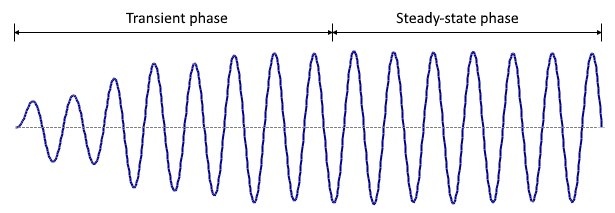Harmonic response analysis
A harmonic response analysis calculates the effect of vibrating load sources on a structure. Typical harmonic load sources include vibrating machines such as crushers, pumps or vibrating tables, footfall excitation caused by people walking, running or jumping, vehicular excitation caused by moving traffic, imbalance in rotating parts of a machine, etc.
Capabilities
-
When the structure begins responding to the harmonic loads it goes through an initial "transient phase" during which it moves in an irregular way while it "catches up" with the vibrating load sources. It then reaches a steady oscillating motion called its "steady-state phase". A harmonic analysis is concerned just with the steady-state phase of the structure's response. If you are interested in the transient phase or if your vibrating loads are not harmonic then you should run a transient response analysis instead. Note that the amplitude of the oscillations in the transient phase can exceed those of the steady-state phase.

-
Supported harmonic load types are "Applied loads" (vibrating masses at nodes), "Base displacement", "Base velocity" or "Base acceleration" (support nodes vibrating in-phase).
-
Each load source is assumed to be vibrating in a sinusoidal (harmonic) motion with a user specified frequency and phase.
-
Load sources operating at different frequencies and phases can be combined within a harmonic load case.
-
Harmonic result load cases can be combined with static and other load case types using combination load cases.
-
Damping can be taken into account and applied as either "Modal" or "Rayleigh" damping, or it can be disabled.
-
You can choose between "Time sampling" or "Frequency sampling". Time sampling evaluates how the structure responds over a specified period of time (ie. a time-history response), whereas frequency sampling evaluates how the structure responds to a specified range of frequencies (ie. a frequency response). Frequency sampling allows you to display a resonance curve that shows the effect of each frequency on the excitation of the structure.
-
You can choose the time or frequency range and the number of steps over that range at which calculations are done.
-
When frequency sampling is used, you can define and apply a "Factor versus frequency table" that allows you to change the magnitude of the applied loads as the frequency changes.
-
After a harmonic response analysis, the model can be animated to show how it responds to the harmonic loads.
-
Displacement, velocity, acceleration and phase diagrams can be displayed for any nodes in the structure. These are time-history curves if time sampling is used or resonance curves if frequency sampling is used.
-
Each time or frequency step (or just selected steps) can be converted to result load cases that contain displacements, forces, moments, stresses and reactions, just like you would get from a static analysis. You can show diagrams or get reports for these load cases or use them in the normal way in any of the design modules.
Important points
-
A harmonic response analysis is linear only and therefore cannot be performed if your model contains cable elements.
-
Because it is linear, a harmonic response analysis treats tension-only and compression-only members as normal members that can take tension or compression.
-
P- D and P- d effects are not taken into account during a harmonic response analysis.
-
A buckling analysis cannot be performed with harmonic load cases and therefore compression effective lengths from a buckling analysis are not available when doing a steel member design/check on harmonic load cases. If you are performing a steel member design/check on combination load cases that contain a mixture of static and harmonic load cases then the harmonic load cases will not contribute to the calculation of the compression effective lengths. This may not be correct and so you should consider specifying your compression effective lengths manually in those cases.
-
A harmonic response analysis requires a dynamic frequency analysis to be conducted first.
-
The harmonic response analysis must be repeated after a dynamic frequency analysis because its results will have been deleted.
-
The accuracy of the harmonic response analysis depends on the accuracy of the dynamic frequency analysis on which it is based. It is therefore important that you set up your model correctly to achieve accurate dynamic frequency analysis results. For example, if master-slave constraints are used then positioning of the master nodes is particularly important for correct mass distribution. For more information, refer to "Dynamic frequency analysis".
For a full step-by-step guide on how to prepare for and perform a harmonic analysis, refer to "Step by step guide to harmonic response analysis".